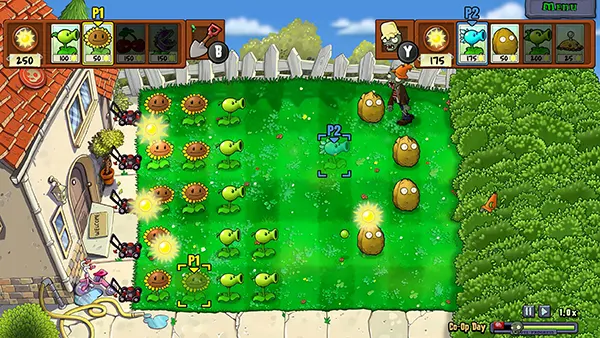
Plants vs. Zombies remains one of the most recognisable mobile strategy games in 2025, thanks to its clever mix of tactical gameplay, humorous design, and steady progression. Players manage limited space, select suitable plants, and react to unpredictable enemy waves, making each session engaging and repeatable. The title continues to appeal to a wide audience because it balances simplicity with thoughtful decision-making, offering a challenge without overwhelming the user.
The foundation of Plants vs. Zombies lies in organising defensive plant lines across several lanes while facing constant pressure from incoming zombies. Every plant type plays a unique role, whether it is generating sun, slowing opponents, or dealing damage. This encourages players to evaluate threats and select appropriate tools to reinforce their garden. Over time, new plants and enemy variations broaden tactical choices and keep the experience fresh.
Energy management is essential, as players rely on sun points to build and maintain their defence. Early decisions determine whether the garden becomes stable or collapses under increasingly intense waves. This creates a natural learning curve, rewarding users who analyse each level and adapt to timing, plant cooldowns, and enemy speed. The structure motivates players to refine strategies instead of repeating the same layout.
The later stages introduce additional elements such as fog, limited visibility, and randomised lanes, requiring situational awareness. Each change forces players to reconsider their standard approaches, ensuring that even long-time fans continue to find new challenges. These environmental features make the game feel more dynamic without sacrificing clarity or accessibility.
Offensive plants form the backbone of most strategies, providing the damage required to eliminate incoming zombies. Options range from simple pea shooters to more advanced multi-lane attackers, allowing users to create layered defensive patterns. The effectiveness of each plant depends on timing, placement, and synergy with supporting units.
Support plants contribute to the sustainability of the garden. Sunflowers, for instance, are essential for resource generation, while slowing plants help control movement speed and buy time during heavy waves. These elements encourage balanced planning rather than relying solely on high-damage options.
Defensive plants add durability by protecting vulnerable lines and delaying zombies long enough for offensive units to finish them off. Wall-type plants, barriers, and shield-based options allow players to create structured frontlines. This defensive layer enhances control over enemy flow and reduces the risk of sudden breakthroughs.
The zombies in the game are not merely identical threats; each variant introduces new behaviour patterns. Some move faster, some carry shields, and others can bypass plant defences entirely. This diversity keeps players alert, urging them to anticipate unusual movements and adapt before the situation escalates.
Boss encounters further elevate the difficulty, demanding precise placement and rapid reaction. These larger foes often introduce mechanics unseen in regular waves, such as area attacks or defensive armour. They challenge the player’s understanding of plant combinations and pressure-management skills.
As the game progresses, later levels mix several enemy types at once, creating layered threats. Mastery requires reading the lane layout, understanding attack timings, and adjusting the garden arrangement mid-round. This maintains long-term appeal even for experienced players familiar with early-level patterns.
Different stages alter both plant options and zombie actions. Night-time levels introduce limited visibility and require plants suited for darker environments, changing how players allocate resources. This shift forces new priorities, particularly for early defence.
Pool and roof stages modify lane structure, affecting movement and plant placement rules. Floating zombies and ladder-using enemies require targeted counters, encouraging experimentation with combinations that were unnecessary in earlier levels. These environmental shifts increase complexity while maintaining coherence with the game’s style.
Special event levels, which rotate throughout the year, offer unique zombie sets with distinct behaviours. These temporary modes provide additional motivation for players returning to the game in 2025, as the challenges change periodically. This ensures variety without disrupting the core mechanics players appreciate.

Plants vs. Zombies maintains player engagement through a structured progression system. Levels gradually increase in difficulty while introducing new plants and mechanics, ensuring smooth adaptation. The sense of advancement feels natural, giving players a clear understanding of improvement as they unlock diverse tools.
The game also features mini-games and side modes that break up the main campaign. These shorter challenges explore alternative mechanics, offering lighter, creative tasks. By experimenting with different rulesets, such modes strengthen understanding of how certain plants behave under unusual circumstances.
Daily tasks and seasonal objectives provide modern mobile-style longevity. Players can earn rewards by completing rotating challenges, which encourages regular short sessions. This design has helped keep the game relevant in 2025, appealing to those who prefer casual but strategic mobile experiences.
Adaptability becomes crucial as the game introduces unpredictable waves. Learning when to adjust plant placement or change priorities mid-battle separates casual play from more advanced decision-making. These moments encourage reflection and refinement of earlier strategies.
As players encounter new plants, the game invites experimentation with formations and synergy chains. Certain combinations produce unexpected efficiency, rewarding those who explore beyond basic setups. This experimental aspect contributes to the game’s longstanding popularity.
Throughout the campaign, the player’s garden evolves from a simple basic field into a carefully curated defensive system. Observing this transformation fosters a sense of accomplishment. Each completed level strengthens familiarity with mechanics and deepens strategic awareness.